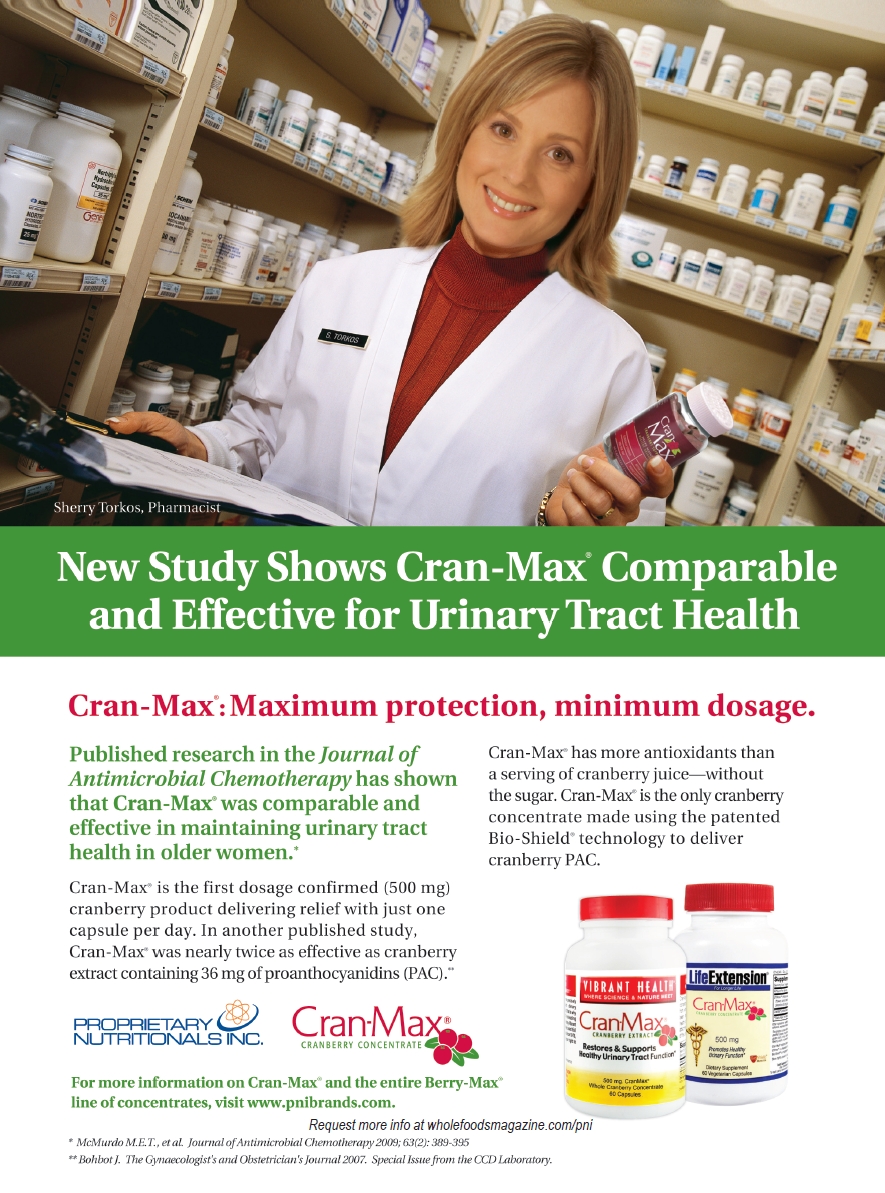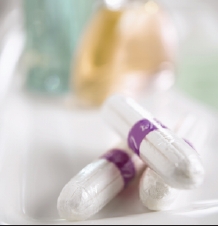As we move into a more health- and environmentally-conscious age, it is a wonder why feminine hygiene products have not been a bigger part of the conversation.
In recent years, women from all walks of life have become more aware of the health and environmental risks associated with using conventional pads and tampons. The market for both disposable and reusable natural/organic menstrual products is growing, and retailers should meet the demands of the natural feminine hygiene movement by carrying these items.
What’s Wrong with Conventional?
 Looking at an average box of tampons or pads, most consumers would not suspect that those little wads of “cotton” could carry some huge health risks. By using conventional feminine hygiene products each month, women are exposing the most vulnerable, absorbent parts of themselves (vaginal tissue) to potentially disease-inducing materials and toxins.
Looking at an average box of tampons or pads, most consumers would not suspect that those little wads of “cotton” could carry some huge health risks. By using conventional feminine hygiene products each month, women are exposing the most vulnerable, absorbent parts of themselves (vaginal tissue) to potentially disease-inducing materials and toxins.
The bulk of tampons and pads on the market contain a combination of synthetic, carcinogenic ingredients such as dioxin (made from chlorine bleaching to whiten tampons and pads), rayon, allergy-provoking metal dyes and highly processed wood pulp (1). An additional risk found with cotton if it is not farmed organically is the presence of pesticides and chemicals from the production process (1). Placing these extremely permeable contaminants in or near the vaginal area can lead to irritation, itching, discomfort and other complications (2).
For instance, dioxin is capable of causing abnormal cell and tissue growth in various organs including the reproductive system (3). It can also cause endometriosis, a disease that can bring about cancer and promote infertility (1). Another fear associated with conventional feminine hygiene products, specifically tampons, is the risk for a rare but deadly bacterial infection called toxic shock syndrome (or TSS). This is because the synthetic materials found in conventional tampons can help create the perfect breeding ground for a typically harmless bacteria called S. aureus to enter the bloodstream, wreaking havoc throughout the body that includes fever, seizures and even organ failure (3).
Women are not the only ones affected by these polluting chemicals. Dioxin is making its way into our air,  food and water supply as a result of the chemical manufacturing process (2). A surprising fact is that the U.S. Environmental Protection Agency (EPA) says dioxin poses a serious public health threat and there is no “safe” level of exposure (3). More research is needed about these potential effects.
food and water supply as a result of the chemical manufacturing process (2). A surprising fact is that the U.S. Environmental Protection Agency (EPA) says dioxin poses a serious public health threat and there is no “safe” level of exposure (3). More research is needed about these potential effects.
What Are Your Options?
A woman who wants to make her feminine hygiene routine more natural is in luck. There are a variety of ways in which consumers can decrease or eliminate their risk of being subjected to the harmful chemicals, dyes and other irritants found in mainstream feminine products.
Cotton tampons. The best way to go in terms of tampons are those that use organic cotton. The pesticides of conventional cotton do not go away when formed into tampons, and having an item that is possibly GMO (70% of cotton is considered genetically modified) and pesticide-filled around such an intimate area does not do the female body any favors (1). One organic brand, for instance, offers biodegradable cardboard applicators and a wavy-construction cotton fiber that interlocks and prevents loose fibers from releasing into the body.
Pads/liners. When looking to sanitary pads and liners for period protection, steering clear of synthetics laced with bleach, perfumes and dyes designed to make these items more appealing to the average female consumer might be a step in the right direction. Organic pads and liners free of chemical risks and irritants could benefit those who want healthier disposables. Many women also find organic cotton products to be softer and less irritating than their conventional counterparts.
Cups. A great way to aid in the eco-friendly feminine product effort is to use reusable menstrual cups. These latex or silicone cups are folded and then inserted into the vagina in an attempt to “catch” menstrual blood before it leaks out (4). This washable cup can stay inside for up to 12 hours and can greatly minimize feminine hygiene expenses and landfill waste (5). It is important to mention that the cup should be sterilized after each cycle to maintain cleanliness by boiling or using baby bottle sanitizing solution (5). Some women find these products less drying than tampons; they are also said not to disturb vaginal pH (5).
Sea sponge tampons. For those willing to go as natural as possible, sea sponges are an option. Reusable and washable sea sponges have been described as more comfortable and less irritating to some consumers than more typical approaches. They are similar to the cup in the way they protect from leakage and minimize environmental damage, and are said to contain enzymes that can act as odor blockers once in use (6).
Why Organic/Natural Over Conventional?
In a society obsessed with the latest health and eco-friendly innovations, feminine health is a reasonable concern for women looking to optimize their healthy lifestyle.
If a consumer is considering the environmental aspect, organic pads and tampons are eco-friendly disposable options due to their lack of synthetic materials and pollutants. Also, the use of reusable products like cups saves money and shopping trips, in addition to decreasing the damaging waste mounting up in the environment. WF
|
Maloney’s Bill If you find yourself understandably concerned about the safety of mainstream feminine products, you are in good company. Recognizing the potential health risks and lack of awareness surrounding the feminine hygiene business, Congresswoman Carolyn B. Maloney (D-NY) has reinstated a bill that would aid in studying the definitive health effects of feminine hygiene products. Named the Robin Danielson Feminine Hygiene Product Safety Act after 1998 TSS victim Robin Danielson, the bill demands government agencies like the National Institute of Health (NIH) and the U.S. Food and Drug Administration (FDA) to strengthen their research into the synthetic substances commonly found in most feminine products (1). This bill would also urge the publication of known toxins found in these items. If this safety act successfully makes its way through Congress, independent investigations will be conducted into the full extent of feminine product effects on health and the environment. With Maloney’s first feminine health-related effort being the 1997 Tampon Safety and Research Act, the answers to feminine product questions are eagerly awaited by a public concerned with what they put in or near their bodies. Maloney introduced versions of the bill in 2003, 2005, 2008, 2011 and 2014. Reference 1. “Maloney Bill Would Study Health Effects And Safety Of Feminine Hygiene Products,” April 2, 2015, http://maloney.house.gov/media-center/press-releases/maloney-bill-would-study-health-effects-and-safety-of-feminine-hygiene, accessed July 7, 2015. |
References
1. Natracare, www.natracare.com, accessed July 7, 2015.
2. Maxim HY, www.maximhy.com, accessed July 7, 2015.
3. Dr. Mercola, http://femininecare.mercola.com/products/organic-tampons.aspx, to accessed July 7, 2015.
4. E. Ross, “Tired of Tampons?” Cleveland Clinic, Feb. 9, 2015, http://health.clevelandclinic.org/2015/02/tired-of-tampons-here-are-pros-and-cons-of-menstrual-cups, accessed July 7, 2015.
5. Diva International, www.divacup.com, accessed July 7, 2015.
6. Sea Sponge Company, www.seaspongecompany.com/products/sea-clouds-sea-sponge-tampons, accessed July 7, 2015.
Published in WholeFoods Magazine, August 2015, (online 7/17/2015)










